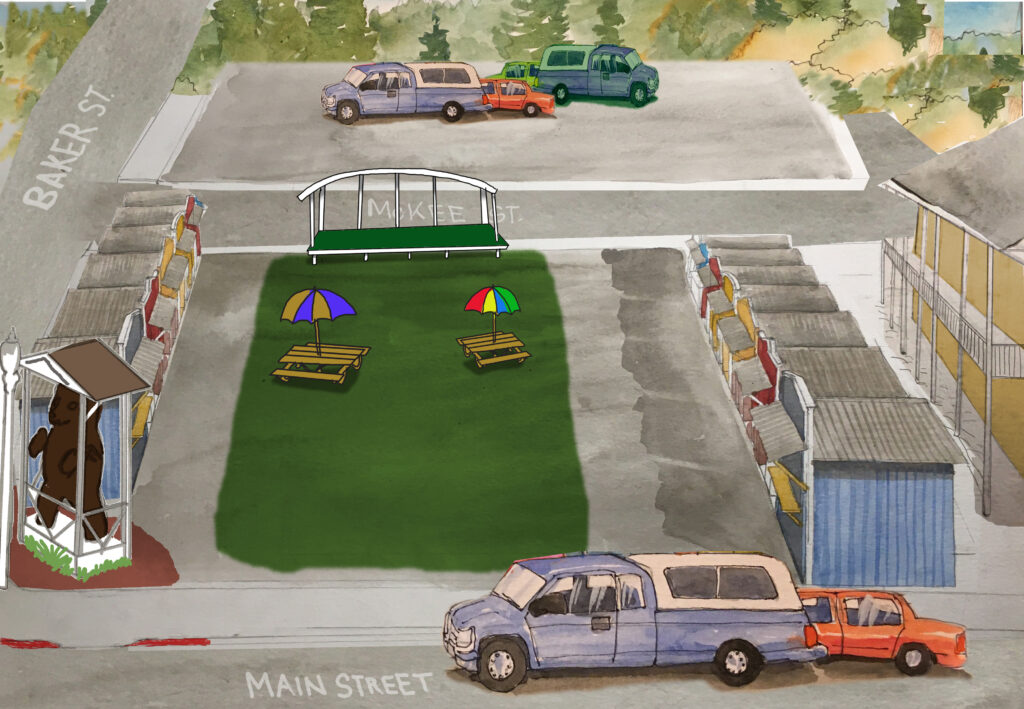Bear Square Market Village proposal paused for one year
By Janet Clark
Edited by Katy Tomasulo
The concept of a “shed market village” in the Bear Square parking lot at 45938 Main St. has been bandied about for several years as a potential hub for small businesses and artisans. Mayor Jason Miller passionately supports the concept; Valerie Stafford, president of the Concrete Chamber of Commerce, just as adamantly opposes it.
Miller asked the Concrete Town Council to pass an Approval to Seek Funding resolution at the council meeting on April 11. His plan, which he said he has researched since 2018, would eventually replace the Bear Square parking lot with two rows of 10×10-, 12×10-, or 14×10-foot sheds, purchased from Heritage Portable Buildings and customized with facades designed to look like Concrete Town Center buildings in the early 1900s.
The sheds would be used as shops for small businesses and microbusinesses in Concrete and the Upper Valley to sell handmade, assembled craft, or artisan products without the high overhead of brick-and-mortar buildings. The sheds would be owned by Town of Concrete and rented to local entrepreneurs. Between the rows of sheds on the east and west sides would be a green space with picnic tables and at the north end a stage. Lost parking space would be replaced by razing the current Public Works buildings in the block just to the north, which would double the parking capacity.
For Miller, this is “another tool in our economic development toolbox” that has a very low threshold for entry, allowing people to get a foot in the door. “Parking lots don’t generate revenue,” he said.
To Stafford, who said at the meeting that she represented the Concrete Chamber of Commerce, its Board of Directors, and the Town Center Task Force, even the concept is doubtful. “I want you to know that the business community, those groups of people, are opposed to the idea of changing the Bear Square parking lot into a shed village,” she said.
Stafford said that they believed the premise of the project was wrong, they didn’t believe that temporary sheds in a parking lot without running water and heat, relying on porta-potties, and only open temporarily and seasonally, would “enhance the look or the feel of Town Center in any way and it will not help our existing businesses.” They also believed the products of some sheds might be in direct competition with business models currently being explored by owners of existing, permanent, historic buildings.
“Easy, ample parking is not an amenity we can afford to lose,” Stafford said. Eliminating or moving the parking lot would make customers park in front of businesses they weren’t shopping at and require walking further, she said, making it especially difficult for senior and disabled customers.
Questioning the town’s priorities, Stafford talked of several projects that she said need attention, like cleaning the Thompson Bridge, a dog park, picnic tables in Silo Park, an approved trail system, and different signage. Stafford said that the highest priority should be supporting new and existing businesses.
Anne Bussiere, owner of Annie’s Pizza, and Betty Seguin, who said she is heavily involved with the library, spoke of their concerns for senior and disabled access to the library and businesses, as well as RV parking. Bussiere said, “That parking lot, where it is, is like the jewel that we’ve managed to retain all these years.”
While the Chamber of Commerce and the Town Center Task Force oppose the project, Town of Concrete Economic Development Commission Chair Eric Archuletta supports it. He said the concept had been well-researched and is “basically replicating a successful project, so it’s not something that has been pulled out of thin air.”
Miller stated that market villages have success stories all over the country. While the sheds would have electricity and could be heated, making year-round use possible, there would be no running water. He also said, “The focus is not on creating competition, the focus is steering clear of competition.”
Miller said that in other places, “the very businesses that thought they would be losing business to the newcomers found out that their business increased because that shed market village became an amenity to the town.”
He described an incremental timeline of five phases over five years, the first phase being site preparation with surveying and electrical installation; the second installing the first two sheds, which would take up two of the 19 current parking spaces in Bear Square. One shed would be 10×10 at a currently quoted total price of $12,669.96. The second would be a 12×10 at $17,513.54. Miller had hoped to apply for Skagit County Economic Development Grant funds to pay for the first two sheds.
Phases three to five would see the installation of the remaining sheds and porta-potties with hand-washing stations, razing of the Public Works buildings in steps as parking is prepped, and completion of the green area between the sheds, along with bandstand construction. Miller said that parking would be approximately doubled at the end of the estimated five-year build-out. As for the extra walking distance, Miller insisted that if the draw is strong enough, people will walk.
After Miller’s presentation and the comments, councilmembers questioned the need, the town’s priorities, the demolition of the Public Works buildings, parking, and the perception of a lack of support from businesses. The council concluded that they needed to hear directly from business owners, after they had been given the same information, before proceeding.
Miller arranged to give his presentation to an estimated 25 to 30 business and property owners in Bear Square on April 22. A question-and-answer period afterward brought out the same concerns as in the council meeting and more—loss of parking, walking distance from parking, pedestrian crossing safety on Main Street, cut-outs in curbs for the disabled and strollers, its chance of drawing people off the highway, competition with the Saturday Market and businesses, the timing, other projects, and more. Overriding anything else, though, was the location and loss of Bear Square as it is.
A few people indicated support for the shed market village. Others said they might be open to it with further details and plans. Another option voiced was support for the plan if in a different location, such as the Public Works buildings site, Veterans Memorial Park, or as an expansion of the Concrete Saturday Market and at that location, but definitely not in Bear Square.
During the April 25 council meeting, the discussion continued. A large group attended, business people spoke out against losing Bear Square, and attendee John Boggs handed out a written history of Bear Square and the codes he thought changing its use would violate. Councilmembers concurred that existing businesses need to be supported, current needs and projects needed to be finished first, and that Bear Square should be left alone.
Miller asked if they wanted to put a stop to the project right then; however, Councilmember Marla Reed made the motion that the project be put back into the planning phase for a year, and Councilmember Michael Criner seconded it. Councilmember Rob Thomas asked that the motion be amended to say that the project does not include Bear Square. The motion passed and Bear Square as a parking lot lives on.
Freelance writer Janet Clark lives in Cape Horn.
Freelance editor Katy Tomasulo lives on Bainbridge Island.







